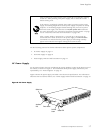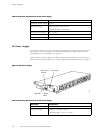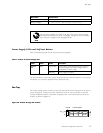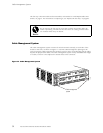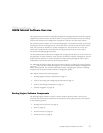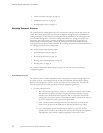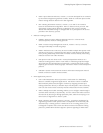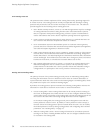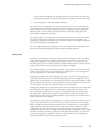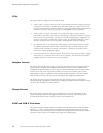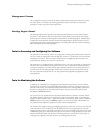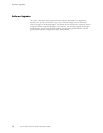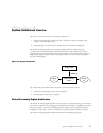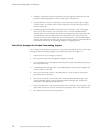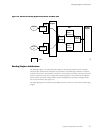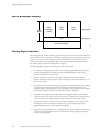Routing Engine So
ftware Components
In the multic a st routing table, the routing protocol process uses traffic flow and other
parameters specified by the multicast routing protocol algorithms to select active routes.
• MPLS routing table—Stores MPLS label information.
For unicast ro
utes, the routing protocol process determines active routes by choosing the
most preferred route, which is the route with the lowest preference value. By default, the
route’s preference value is simply a function of how the routing protocol process learned
about the rou
te. You can modify the default preference value using routing policy and
with software configuration parameters.
For multicas
t traffic, the routing protocol process determines active routes based on traffic
flow and other parameters specified by the multicast routing protocol algorithms. The
routing protocol process then installs one or more active routes to each network destination
into the Rout
ing Engine’s forwarding table.
You can configure additional routing tables to meet your requirements, as described in the
JUNOS Inter
net Software Configuration Guide: Routing and Routing Protocols.
Routing Policy
By default, all routing protocols place th eir routes into the routing table. When advertising
routes, the routing protocols, by default, advertise only a limited set of routes from the
routing table. Specifically, each routing protocol exports o nly the active routes that were
learned by that protocol. In addition, IGPs (IS-IS, OSPF, and RIP) export the direct (interface)
routes for the interfaces on which the protocol is explicitly configured.
For each routing table, you can affect the routes that a protocol places into the table and the
routes from the table that the protocol advertises by defining one or more routing policies
and then applying them to the specific routing protocol.
Routing policies applied when the routing protocol places routes into the routing table are
called import policies because the routes are being imported into the routing table. Policies
applied when the routing protocol is advertising routes that are in the routing table are called
export policies because the routes are being exported from the routing table. In other words,
the terms import and export are used with respect to the routing table.
Routing policy enables you to con trol (filter) which routes are imported into the routing table
and which routes are exported from the routing table. Routing policy also allows you to
set the information associated with a route as it is being imported into or exported from
the routing table. Routing policies applied to imported routes control the routes used to
determine active routes, whereas policies applied to exported routes control which routes a
protocol advertises to its neighbors.
You implement routing policy by defining policies. A policy specifies the conditions to use to
match a route and the actio n to p erform on the route when a match occurs. For example,
when a routing table imports routing information from a routing protocol, a routing policy
might modify the route’s preference, mark the route with a color to identify it for later
manipulation, or prevent the route from even being installed in a routing table. W hen a
routing table exports routes to a routing protocol, a policy might assign metric values, modify
theBGPcommunityinformation,tagtheroutewith additional information, or prevent the
route from being exported altogether. Yo u also can define policies for redistributing the
routes learned from one protocol into another protocol.
JUNOS Internet Software Overview
25



